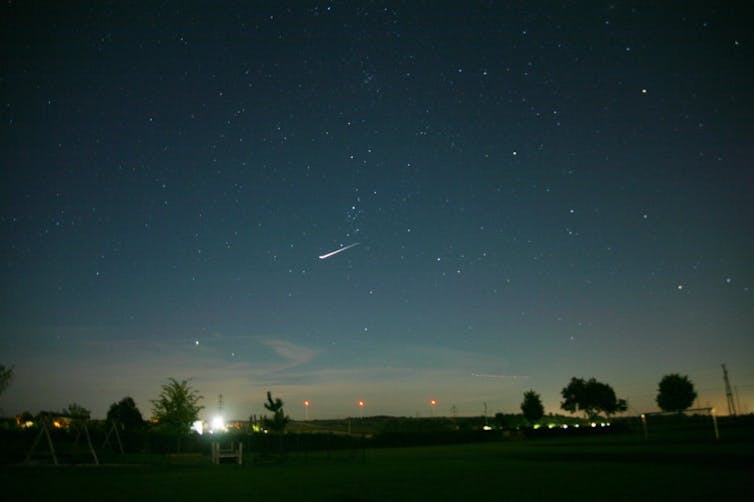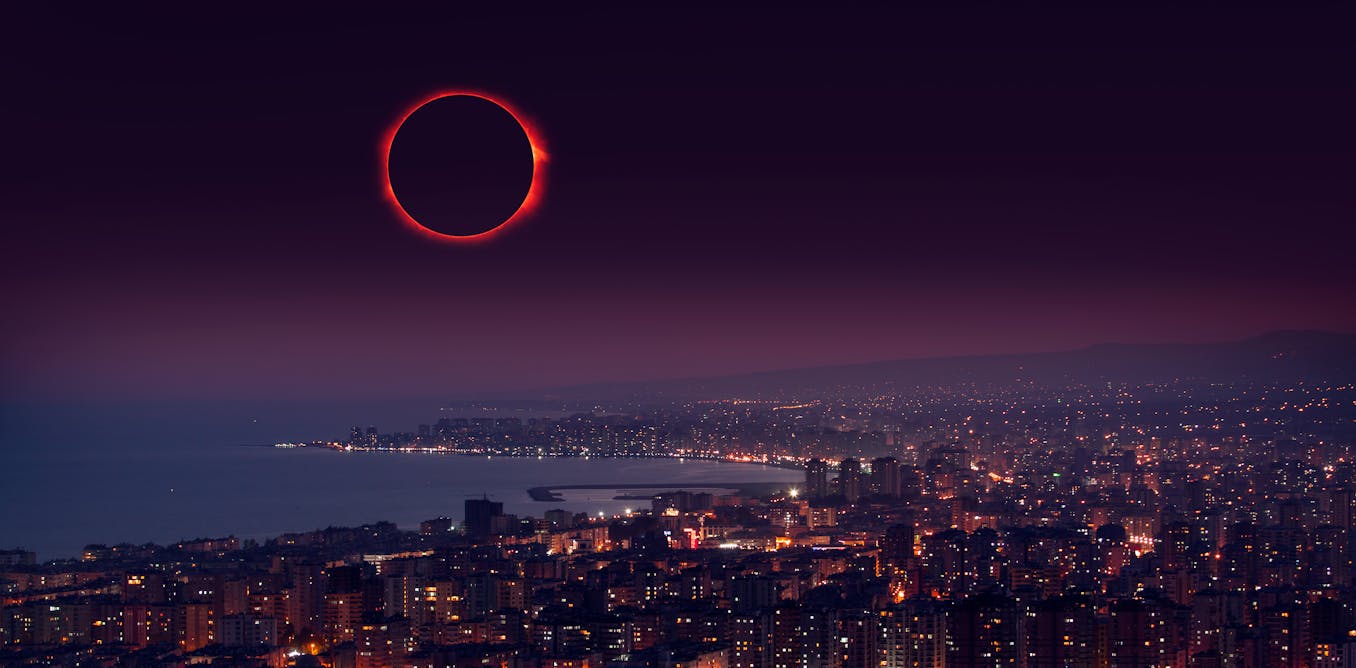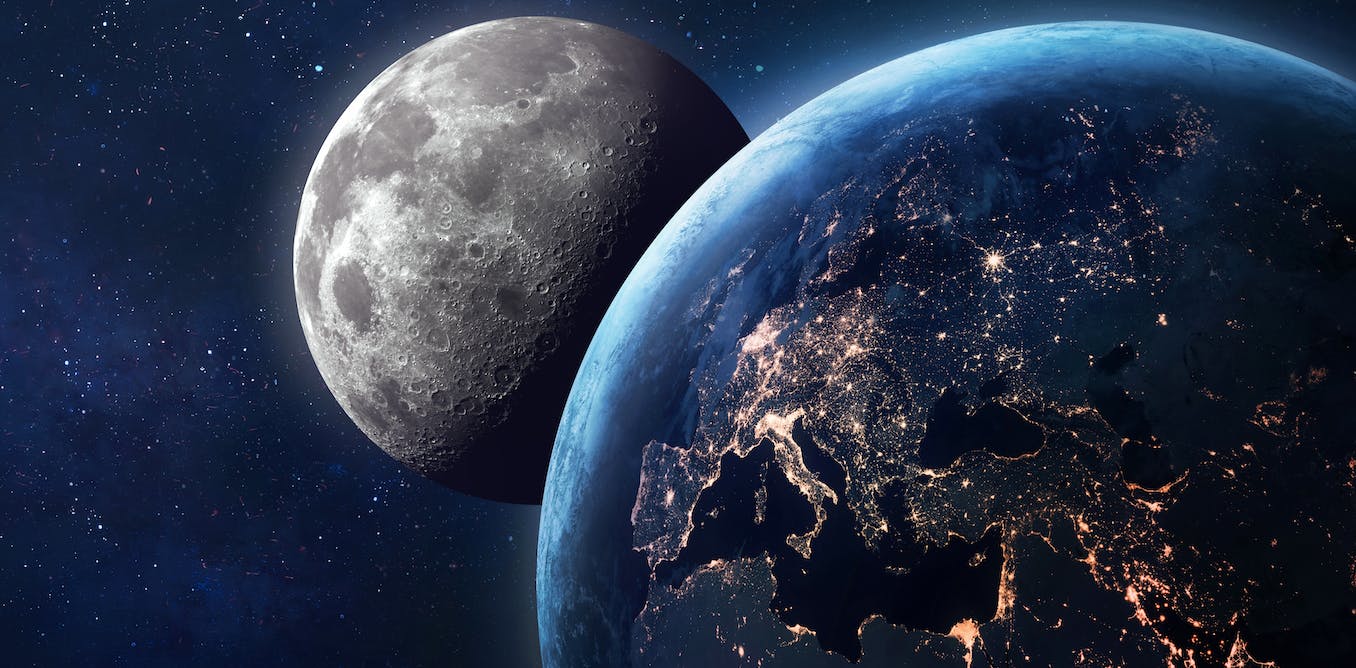Solar eclipses have been a source of both scientific discovery and pure awe. On April 8, millions of people across Mexico, the United States and Canada will have the chance to see a total solar eclipse.
There is enormous public interest in viewing the eclipse: revenue from tourism is expected to top US$1 billion, comparable to the Super Bowl.
But as the sky darkens and the corona appears, will viewers also see some of the thousands of new Starlink satellites that are visible in night skies worldwide?
Fortunately, eclipse watchers are unlikely to see satellites tracking across the darkened sky during totality. But some may see brief, bright glints caused by sunlight reflecting off the surfaces of satellites and abandoned rocket bodies in orbit.
Bright satellites in the night sky
In response to the dramatically increasing number of satellites being deployed in Low Earth Orbit (LEO), and the growing fraction of astronomical research that is being negatively impacted by satellite streaks, our team of astronomers built a simulation of how bright satellites will be in the future sky at any time of night.
Our prediction is that one in 15 visible stars in the sky will actually be a moving satellite, not a star.
Read more:
Soon, 1 out of every 15 points of light in the sky will be a satellite
Our simulations include 65,000 satellites in LEO: the planned megaconstellations of Starlink, OneWeb, Amazon Kuiper and StarNet/GW.
Currently, there are over 9,500 functional satellites in orbit, fully 60 per cent of which are Starlink satellites launched in the past five years. These 5,700 Starlink satellites are bright and most are visible to the naked eye anytime they are sunlit and high in an observer’s night sky.
How bright are satellites during a total eclipse?
We wondered if any of the thousands of satellites currently in LEO would be visible as the shadow of the moon sweeps across North America on April 8.
The brightness of satellites during the eclipse depends most strongly on how close the satellites are to observers on the ground. Satellites directly above are brightest simply because they are closest.
In our simulation, we found that all satellites visible in the sky during the eclipse are inside the moon’s shadow, making them fainter than they would be otherwise. We also found that light reflecting off the sunlit surface of the Earth — Earthshine — was a significant source of illumination on satellites overhead.
(S. Lawler, H. Rein & A. Boley), CC BY
When all these effects are taken into account, we predict the brightest satellites would be visible to the naked eye from a fully dark location. But during an eclipse, the sky is not very dark — it is even brighter than the night sky during a full moon, making only the brightest stars visible. For this reason, we do not expect these satellites to be visible as “moving stars”.
Satellite glints are becoming more common
But this does not mean that satellites will have no effect. Indeed, glints from satellites and orbiting debris may be easily visible.
Glints are short, bright reflections from large, flat surfaces on satellites and tumbling, abandoned rocket bodies. Rocket bodies in particular are expected to be a significant source of bright glints, and there are thousands of these bus-sized, tumbling objects in orbit.
Our brightness model uses a simple sphere for predicting satellite brightnesses, which does a reasonable job of reproducing the overall brightness distribution, but does not include glints. Predicting glints requires knowing the exact shape and orientation of each satellite, which most megaconstellation operators consider proprietary and do not share with anyone outside their corporations.
The space situational awareness company Privateer has a publicly available, realistic glint predictor, which could help astronomers avoid burning out their sensitive cameras on the brightest glints. But Starlink has already changed its design multiple times since providing this information to Privateer, and is under no obligation to publicly share this data, so while helpful, the use is currently limited.

(Peter Nussbaumer/Wikicommons), CC BY
Documenting the eclipse
The way to test our prediction of visible glints is through images taken during totality. Weather permitting, our team will attempt to take some observations.
But we also invite viewers to take images during totality. A good digital camera is all you need. Wide-field images of a large portion of the sky are ideal, a fish-eye lens would be great. Choose a wide aperture, and an ISO of 1600 to 3200 so that you can see faint objects without too much noise in the image. The exposure time should be long enough to see satellite trails, but not too long to saturate the image. Depending on your setup, roughly 10- to 30-second exposure times might work.
If you think you saw some satellites, either as a moving star or as a short glint, let us know. Totality will be a few minutes at best, so you need to have a setup that is ready to go when totality arrives. A timer would be ideal, so you can let the camera record the sky while you focus on enjoying the eclipse.
Read more:
Photographing the eclipse? You’ll join a long history of people seeking proof of experience
Satellites are changing the sky, worldwide
Satellites are changing every aspect of stargazing and astronomy research, as well as polluting the atmosphere and threatening the future use of Earth orbits.
While we don’t expect many satellites to be directly visible during the 2024 total eclipse, we do anticipate that glints could be visible to the unaided eye as brief flashes, highlighting the breadth of astronomical observation that is being degraded.
If you are fortunate to be along the path of the April 2024 eclipse, go out and enjoy it. And after the eclipse, make an effort to immerse yourself in any dark night skies you have access to.
With the rapid commercialization of orbit, everything in the sky is changing fast.




